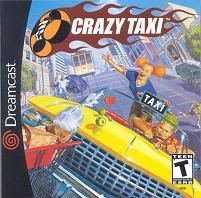 Crazy Taxi
Crazy Taxi
Publisher: Sega
Developer: Hitmaker/AM3
Genre: Driving
Release Date: 1/24/2000
Has it really been eight years since Crazy Taxi was ported from arcades to the last Sega console. Crazy Taxi was one of the Dreamcast’s biggest hits, selling over 1 million copies. It was the first game in the arcades to use Sega’s (then) powerful NAOMi board and was the first video game capable of maintaining a frame rate of 60 fps per second, highlighting just how powerful the Dreamcast was compared to other systems at the time.
Crazy Taxi was one of those few pre-2001 games that really managed to hit mainstream popularity. The game was highly addictive, sported a soundtrack featuring The Offspring and Bad Religion, and managed to appeal to a wide variety of appeal including non racing game fans. I myself would be counted amongst those non racing gamers.
I admit it. I had a lot of fun with Crazy Taxi on my Dreamcast. I owned the system mainly for SHMUP’s and a lot of Japanese imports like Sakura Taisen 3/4, but I was always shocked how often I would plop that GD-Rom into my loud little white system.
When I moved to the Washington D.C. area, I unpacked all my systems that had been dormant for a few years, and when I hooked up my Saturn and Dreamcast, I was pleasantly surprised to see that after all these years, Crazy taxi was in the console. I thought I had gotten rid of it during one of my many purges.
Over the past few weeks, I’ve picked up Crazy Taxi here and there when I had a free moment between reviewing other games or when I had nothing else to do. The intent was of course to review the game for the DHGF launch, as we don’t really have Dreamcast reviews (as of this writing. It would also give me a chance to see how the game has aged after eight years of technological and graphical advancements.
Does Crazy Taxi still cut the mustard? Or has time passed it by?
Let’s Review
1. Modes
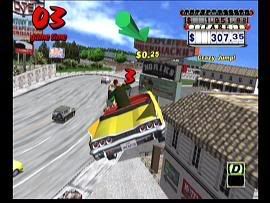 Unlike the Arcade version of Crazy Taxi, the Dreamcast added a lot more content to make it worth the original $49.99 price tag. Besides the “Arcade” level of the game (which is based on San Francisco), the “Original” level is a completely new map to test your driving mettle on. This too is based on San Fran., and it features the same locations, graphics and actors. It’s nothing mind blowing,but it does give you something new if you’re one of those gamers that learned all the bets routes in the Arcade and thus could keep your game going for around 10-15 minutes.
Unlike the Arcade version of Crazy Taxi, the Dreamcast added a lot more content to make it worth the original $49.99 price tag. Besides the “Arcade” level of the game (which is based on San Francisco), the “Original” level is a completely new map to test your driving mettle on. This too is based on San Fran., and it features the same locations, graphics and actors. It’s nothing mind blowing,but it does give you something new if you’re one of those gamers that learned all the bets routes in the Arcade and thus could keep your game going for around 10-15 minutes.
The game also offers a number of mini game challenges in the “Crazy Box.” The Crazy Box starts off with 9 tests, but you can unlock more as you complete vertical or horizontal rows. These activities range from long range jumping to bowling with your car. They’re cute, but I was never really into them. I had a lot more fun driving through the real game.
It’s nice to see Hitmaker provided some options, but even back in ’00, racing/driving games for the home console offered a lot more for your buck. As bad as it was, I remember Need for Speed 2 offered a lot of courses and unlockables. Here we have two courses and a single unlockable in the almighty Rickshaw. What’s here is okay, but you can certainly tell that Crazy Taxi was a bare bones game designed to sell the power and graphics of the Sega Dreamcast rather than provide any in depth gameplay or replay value.
2. Graphics
Even today, Crazy Taxi is a pretty game. The character designs of your four cabbies are well done, and the background details like the stores, park, and moving vehicles still hold up today. The Dreamcast really was a graphics powerhouse at times, which makes me sad it died such a quick death, This is one of those games that is just as fun to watch as it is to play, simply due to the mass of chaos on your screen.
The game’s pedestrians do leave something to be desired however. They weren’t well done for 2000, and they definitely haven’t aged well. It’s the only black mark in the graphics for an otherwise great looking game. Aside from a few Japanese only releases, Crazy Taxi is arguably the best looking game on the Dreamcast.
3. Sound
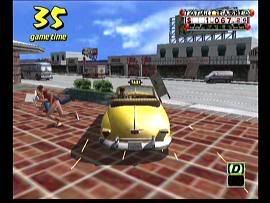 When you think Crazy Taxi, you think of the soundtrack. This was one of the first games to feature major artists. In this case, Bad Religion and The Offspring would play with every turn behind the wheel. Crazy taxi helped boost both band’s popularity with people unfamiliar with their music, as well as get fans of both bands playing Crazy Taxi. I’ll admit I only like The Offspring’s first album way back when I was in High School, but for me (and many others), “All I Want” is always going to be, “The Crazy Taxi Song.” It’s forever imprinted in the brains of those that have played this game, and is easily the most familiar song in the gang.
When you think Crazy Taxi, you think of the soundtrack. This was one of the first games to feature major artists. In this case, Bad Religion and The Offspring would play with every turn behind the wheel. Crazy taxi helped boost both band’s popularity with people unfamiliar with their music, as well as get fans of both bands playing Crazy Taxi. I’ll admit I only like The Offspring’s first album way back when I was in High School, but for me (and many others), “All I Want” is always going to be, “The Crazy Taxi Song.” It’s forever imprinted in the brains of those that have played this game, and is easily the most familiar song in the gang.
The soundtrack to Crazy Taxi helped really empathize the punky-counter culture feel Hitmaker was trying to portray with this game. It was one of the best fusions of actual bands and video gaming goodness, and it still remains one of the best examples of the two blending together. These days, it’s no longer a rarity, but aside from Guitar Hero and Rock Band, no other soundtrack for a game has ever come close to tying a real major recording group with a video game. Very impressive indeed.
4. Control and Gameplay
Crazy Taxi has very simple controls In fact, you only use half the buttons on the Dreamcast controller. Use A and B to shift between forwards and revers, and then the trigger buttons for breaking and accelerating. No real problems here.
Each cab has it’s own specialty and weakness. For example, B.D. Is the fastest but has the least level of control. Gena accelerates and breaks faster than the other cabs, but has has the lowest maximum speed. These differences are really subtle however, and only are noticeable if you play the game a lot, switching between cabs each time.
You have a limited amount of time (although this time changes by whether you are playing by Arcade rules or a set timer) to pick up as many passengers as you can and deliver them to their destination of choice. The faster you go, the more money and time you earn. You can earn bonus money by performing wacky tricks and stunts on the highway.
A lot of the big trick moves that earn you cash in the game are a bit difficult to pull off unless you really master the game. In order to earn that Class B or A license, you have to be able to pull off things like the Crazy Stop (Hit the brakes and reverse at the same time) or the Limit Cut, which is a series of Crazy Dashes. I’ll be honest. As much as I love the game, I suck at driving games and have yet to be able to pull off the Limit Cut, even 8 years later. Doesn’t mean I don’t respect or appreciate the game though.
Crazy Taxi is amazingly fun, even if you suck at the game. It’s short enough and the controls are simple enough that you can’t get mad or frustrated. There’s always silly things going on or being sad to turn that frown upside down. It’s a great game to get people into the driving/racing genres, but like most games in that line, CT has some control options that the vast majority of gamers won’t even know are available to them, much less being able to pull them off.
5. Replayability
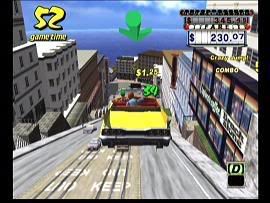 You’re always going to be on the same two courses, but unless you memorize the game board for the best fares, every game will play out differently each time. With all the options, playable characters, and potential for maxing out your score, Crazy Taxi is a game you can’t help but be drawn back to time, and time again – a hallmark of a truly well made arcade game.
You’re always going to be on the same two courses, but unless you memorize the game board for the best fares, every game will play out differently each time. With all the options, playable characters, and potential for maxing out your score, Crazy Taxi is a game you can’t help but be drawn back to time, and time again – a hallmark of a truly well made arcade game.
The Crazy Box just helps to increase replayability for this title, and although it’s not as “Score Attack” based as the rest of the game, you do have a lot of fun trying to solve the challenges being offered up to you.
Even today, Crazy taxi remains my most replayed game on the Dreamcast (Followed by Cannon Spike and Touken Retsuden 4). I can’t image anyone getting sick of this game, or more importantly – anyone that can’t have fun with it. It’s short, easy to play, and you just want to get that higher score or hear the Wolfman Jack impersonator reward you with your license at the end of the game.
6. Balance
This is probably the one flaw with Crazy Taxi. You’re going to get a lot of Class D and E licenses until you start to realize every passenger is in the same spot every time you play, and they’ll always want to go to the same place. Memorization and lots of practice of the special stunts are the only way to propel yourself to the higher licenses. In order to get really good at the game, you’re going to have to spend a lot of time in three minute sessions. Now in the arcade this made sense. A high level of addictiveness coupled with a high degree of challenge for obtaining the highest score/license makes one a ton of money. Especially in the dying realm that is arcade gaming. This type of difficulty has never translated well to the console market except for those of use that game simply to game or who are high score masochists – a breed of gamer that really doesn’t exist anymore.
Thankfully Crazy Taxi offers the 5/10/20 minute game sessions as well, which will be a boon to the majority of the people who play the game. Here you can dick around and try out all the stunts. It’ll give you a chance to memorize the course and then move on to the “real” style of play – aka the “arcade Rules.”
If it was just the 180 second Arcade sessions, then I’d have had to give Crazy Taxi low marks. Instead, the Crazy Box and new methods of play make it easier to learn to do the higher level functions of the game.
7. Originality
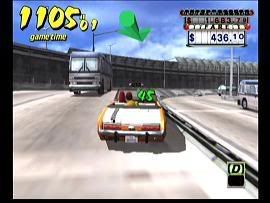 Although it’s spawned four sequel, of which only Crazy Taxi 2 was any good, the original was an amazing piece of innovation, both in terms of gameplay and technological advances. Graphically and musically, Crazy Taxi was far ahead of the curve and even today it still outperforms games on the 360, Wii, or PS3.
Although it’s spawned four sequel, of which only Crazy Taxi 2 was any good, the original was an amazing piece of innovation, both in terms of gameplay and technological advances. Graphically and musically, Crazy Taxi was far ahead of the curve and even today it still outperforms games on the 360, Wii, or PS3.
Gameplay wise, Crazy Taxi turn the arcade racing genre on its head. Instead of being a simple three minute game, you were rewarded with more play time the better you excelled at the game.
Most of all, Crazy Taxi did something no other game had really done at the time, and that was include some of the most blatant product placement ever. KFC, Pizza Hut, Levi’s Jeans, and more were locations in the game you had to ferry your passengers to. Oddly enough, it worked. It didn’t feel like selling out or cheap advertising. Instead it made the game feel more realistic and comfortable, especially to the large casual gaming audience the game picked up. It was well done and unlike other games that have had product placement, this helped make the game more enjoyable.
Crazy Taxi not only oozed style and charm, but it also helped keep the US arcade scene alive longer than people expected and became one of Sega’s last great universal hits before being decimated by Sammy.
Very few games managed to reinvent a single genre. Crazy Taxi managed to do it to several and was for driving games what Final Fantasy 7 and Pokemon did for RPG’s – it hit the mainstream zeitgeist.
8. Addictiveness
Crazy Taxi is a perfect example of how arcade games were meant to be: a large amount of fun for a short amount of time, thus beguiling the customer and getting them to put a lot more money into the cabinet then they otherwise would.
I do find however, that three minutes is the perfect length of time for Crazy Taxi. The extended play options actually make the game a bit tiring and long. Ten Minutes with Crazy taxi feels like forever because new customers never spawn. Once you deliver someone, they never need another ride. Towards the end of extended play, you’re driving around looking for someone. However, the only way to get GOOD at the game is with extended play and so it’s a bit of a Catch-22.
Even with that under consideration, Crazy Taxi is one of those games, you can’t help but fall for. Whether you’re a hardcore gamer, or someone picking up a joystick for the first time, Crazy Taxi sucks you in and leaves you with fond memories and the desire to try it again even years later.
9. Appeal Factor
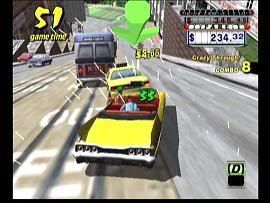 Well this is easy. One of the most successful Arcade games of the late 1990’s/early 00’s, Crazy taxi became on of the best selling games for the Dreamcast and when it was ported to the PS2 and Game Cube, it sold like hot cakes there as well. It’s a title everyone seems to like, if not love, and that little if anything negative can be said about this title. The sequels however…
Well this is easy. One of the most successful Arcade games of the late 1990’s/early 00’s, Crazy taxi became on of the best selling games for the Dreamcast and when it was ported to the PS2 and Game Cube, it sold like hot cakes there as well. It’s a title everyone seems to like, if not love, and that little if anything negative can be said about this title. The sequels however…
One of the most popular games EVER.
10. Miscellaneous
Crazy Taxi is one of those rare games that does nothing wrong, and everything right. It’s a great game all around, from excellent graphics and controls to having memorable music and lines I still hear quoted like, “Let’s go make some cra-azy money!” This isn’t my favorite game on the Dreamcast, but I wouldn’t fault anyone for saying it was theirs. It’s a game that transcends its’ genre, its’ arcade roots, and even the death of the Dreamcast itself. Crazy Taxi will forever be one of Sega’s most famous and popular titles, even after Sammy has dragged poor Sonic and Shining Force through the mud and back again.
The Scores
Modes: Mediocre
Graphics: Great
Sound: Unparalleled
Control and Gameplay: Good
Replayability: Unparalleled
Balance: Good
Originality: Unparalleled
Addictiveness: Good
Appeal Factor: Unparalleled
Miscellaneous: Good
FINAL SCORE: (GREAT)
The Inside Pulse
Crazy Taxi was a system seller in its day, and it still should be. Dreamcasts and copies of this game can be picked up for very cheap if you know where to look. Ignore the weaker PS2 and Gcn ports and go straight for the nearly arcade perfect DC version. It’s one of those few games you’re guaranteed to have fun with no matter how into gaming you are or whatever your genre preferences may be.
Leave a Reply